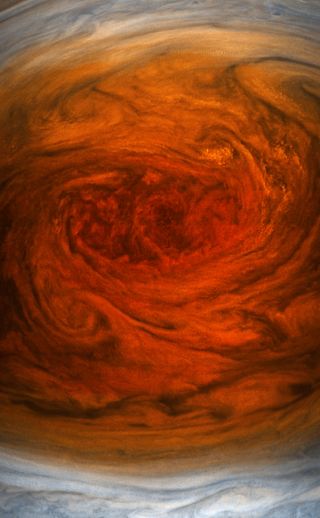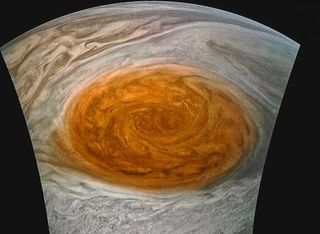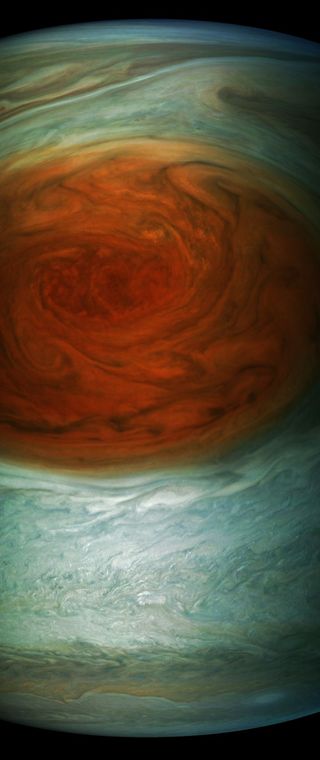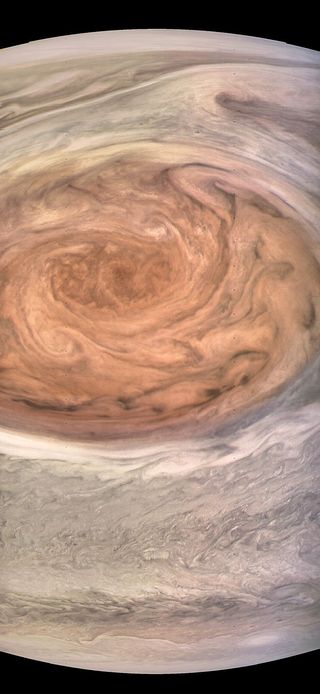Great Red Spot, Spotted! Citizens Create Incredible Images of Jupiter Storm

The swirling, twirling, crimson clouds of Jupiter's Great Red Spot are more hypnotic than ever thanks to images created by citizen scientists using data from NASA's Juno probe at Jupiter.
The JunoCam instrument on board Juno snapped images of the gigantic storm on July 10, and the agency released the raw images to the public on July 12. Now, citizen scientists have processed the images in different ways, highlighting different features of the spot and creating jaw-dropping, hypnotic works of art.
"These highly anticipated images of Jupiter's Great Red Spot are the 'perfect storm' of art and science," said Jim Green, NASA's director of planetary science, in a statement from the Juno team. "We are pleased to share the beauty and excitement of space science with everyone." [More Amazing Scientific (and Artistic) Jupiter Pictures by Citizen Scientists]

Citizen scientists have been doing amazing work processing JunoCam images ever since Juno's arrival at the giant planet in July 2016. You can see all the user-submitted images on the JunoCam website, including featured submissions. Some of those processed images highlight newfound features in Jupiter's clouds — such as relatively tiny, swirling white storms— while other images have utilized the scientific data to create gorgeous, sometimes strange works of art.
"I have been following the Juno mission since it launched," said Jason Major, a JunoCam citizen scientist and a graphic designer from Warwick, Rhode Island, in the statement from the Juno collaboration. "It is always exciting to see these new raw images of Jupiter as they arrive. But it is even more thrilling to take the raw images and turn them into something that people can appreciate. That is what I live for."
This massive storm on Jupiter's surface has been raging for centuries. Astronomers first identified it in 1830, but observations of Jupiter in the 1600s also revealed a giant spot on the surface of the planet (it's unclear, though, if this was the same storm). The Great Red Spot spans a width of 10,159 miles (16,350 kilometers) as of April 3, 2017, according to the recent statement. For comparison, Earth's diameter is about 7,900 miles, or 12,700 km. Wind speeds in the storm are thought to peak at about 400 mph (640 km/h).

Juno arrived at Jupiter on July 4, 2016, and is looping around the giant planet every 53.5 Earth days. The loop is angled around the planet such that the probe gets up close to Jupiter for only about one day during the spacecraft's orbit. During those brief hours, the probe's instruments study the local environment to gather information about the interior of the planet, which will help scientists learn more about the formation of both Jupiter and the entire solar system.
Get the Space.com Newsletter
Breaking space news, the latest updates on rocket launches, skywatching events and more!
The new images come from the probe's sixth close flyby of the planet while collecting data (it did not collect data during its first flyby). The probe's next close encounter will take place on Sept. 1. For each flyby, the JunoCam team asks members of the public to vote on which regions of the planet the camera should focus on. This is the first time that JunoCam has been positioned to photograph the Great Red Spot up close.
The JunoCam instrument was added to the probe primarily for public-outreach purposes, scientists with the mission have said. The instrument has returned the highest-resolution images of the planet's cloud tops ever taken, revealing intricate swirls, veins of color and storms that rise higher in the atmosphere than previously thought, according to Juno scientists.

Scientists don't know how the Great Red Spot gets its crimson color. The planet's upper atmosphere is thought to contain ammonia, ammonium hydrosulfide and water, but scientists don't know exactly how these chemicals might react to create all the colors that appear on the giant planet, according to NASA.
"For hundreds of years, scientists have been observing, wondering and theorizing about Jupiter's Great Red Spot," Scott Bolton, Juno principal investigator who's based at the Southwest Research Institute in San Antonio, said in the statement. "Now, we have the best pictures ever of this iconic storm. It will take us some time to analyze all the data from not only JunoCam, but [also] Juno's eight science instruments, to shed some new light on the past, present and future of the Great Red Spot."
Follow Calla Cofield @callacofield.Follow us @Spacedotcom, Facebook and Google+. Original article on Space.com.
Join our Space Forums to keep talking space on the latest missions, night sky and more! And if you have a news tip, correction or comment, let us know at: community@space.com.

Calla Cofield joined Space.com's crew in October 2014. She enjoys writing about black holes, exploding stars, ripples in space-time, science in comic books, and all the mysteries of the cosmos. Prior to joining Space.com Calla worked as a freelance writer, with her work appearing in APS News, Symmetry magazine, Scientific American, Nature News, Physics World, and others. From 2010 to 2014 she was a producer for The Physics Central Podcast. Previously, Calla worked at the American Museum of Natural History in New York City (hands down the best office building ever) and SLAC National Accelerator Laboratory in California. Calla studied physics at the University of Massachusetts, Amherst and is originally from Sandy, Utah. In 2018, Calla left Space.com to join NASA's Jet Propulsion Laboratory media team where she oversees astronomy, physics, exoplanets and the Cold Atom Lab mission. She has been underground at three of the largest particle accelerators in the world and would really like to know what the heck dark matter is. Contact Calla via: E-Mail – Twitter
